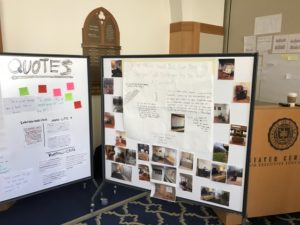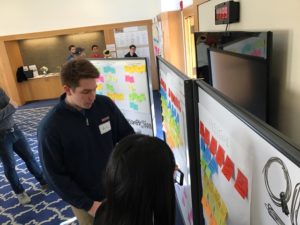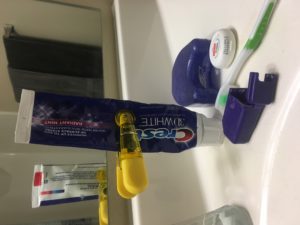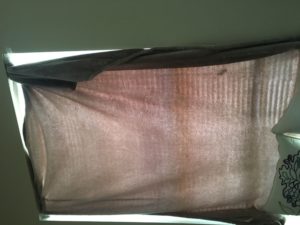*Just like with your ethnographic research, you will want to capture video, photos, and direct quotes.
Category: Projects Spring 2017
Prototype Summary
It looks like the post was interrupted before being finished. We need to go a level deeper on flushing out the ideas and how to invite open communication around them. When prototyping the ideas, you want to invite a discussion around possibilities. If a 3-on-3 basketball tournament came up as an answer to the challenge of engaging more teens, how do you design it to be the most amazing and sought after tournament? What does the ‘entice’ look like? The ‘enter’, ‘engage’, ‘exit’, and ‘extend’. And can you take that idea back a level and present the teens with a menu of different activities they could do at the club and let them rank order what they’d like to do? So think about how will you render the ideas your team has come up with to invite feedback. Cards with images to rank order? A flyer mock up?
For the bus route piece, that is a business discussion. What is the new-to-the world innovation to solve this? Add some creativity around the transportation issue.
Open IDEO Fall Prevention Challenge
This may be a good forum for exchanging ideas: https://challenges.openideo.com/challenge/fall-prevention/ideas?utm_medium=email&utm_source=mailchimp&utm_campaign=fall+ideas+page
Prototype Summary
Nice work outlining the prototypes your team will be taking forward. I encourage you to get a bit more creative with exploring the sharing economy concept around Uber. The article you linked to noted a much higher compliance rate for attending appointments for those with vehicles than those without. Could the population of SJHS create their own Uber of ride sharing? These patients are in poverty, so could they generate additional income? Or perhaps they just car pool and their is a discount or incentive by SJHS if they do car pool? Or could you create a ND volunteer pool, or even minimum wage job, where students sign up and drive patients…
To get feedback on the different ideas, I think you can create some visuals that represent the different options and how the patient would interface with them and have a discussion about what they would have concerns about with each option.
*Just like with your ethnographic research, you will want to capture video, photos, and direct quotes.
For the 5E’s, remember for each idea how your user is “enticed”. This is a big hurdle of how you will compel participation. Implementation of ideas is always the toughest part!
Prototype Summary
You have three great ideas to deliver new and meaningful experiences for the homeless in our community. For prototyping the ideas, your team will want to go deeper. For the pet program, can you take a pet to the homeless and observe who approaches you. How is the demeanor of the homeless person changing? Engage in a discussion about what, if any type of ways they would like to help the animals. You would also be mindful of who didn’t approach. Also, I recently came across a similar service at the Juvenile Justice Center that has had great results: http://www.wndu.com/home/headlines/The-360-Project-finds-a-home-for-dogs-at-Juvenile-Justice-Center-278962741.html
For the life coach concept, consider creating a flyer. Perhaps have a few different strips of paper with different services and ways to engage and interact with the homeless individuals in how they would build the service by “building the flyer” – putting the strips of paper onto the flyer wire frame or into an envelope that would represent what the coaching offering would contain.
For the exercise class, offer one. Who participates? Who doesn’t? Why? Or follow a similar path as the life coach concept and have a discussion over a flyer.
*Just like with your ethnographic research, you will want to capture video, photos, and direct quotes.
For the 5E’s, go deeper here with considering how your user is “enticed”. This is a big hurdle of how you will compel participation. Implementation of ideas is always the toughest part!
Interactive Ethnography: Graffiti Wall
Before immersing ourselves in Wood Ridge Assisted Living, I contacted Angela in order to setup a graffiti wall a week in advance. She suggested that we place the graffiti wall in the employee break room. Our question, aimed towards the caregivers, was, “What advice would you give your younger self to prepare for becoming a caregiver?” After a week, 7 people responded to the question. While this was not the turnout we were looking for, Connor and I gathered some details about caregivers, one of the pivotal stakeholders of our project.
Key Takeways:
- Caregivers do not do the job for money, as they often make low wages.
- Becoming a caregiver takes a lot of hard work, training, and studying. It is not a job simply for kind-hearted individuals.
- Making retirees days gives caregivers immense joy. Fortunately, it is often not tough to make the elderly happy, as they often just need a good listener and company.

Gallery Day Reflection
Getting to discuss the ethnographic research with our client, Pat Karen, helped clear several things up looking forward. First, he highlighted that we did not have a diverse enough population of interviewees. Our group did not include research on several races or socioeconomic statuses, which is a problem going forward. Our product may have to be tailored to the wealthier user, since most of our data is on upper class white men. Second, we need to find a way to incorporate the internet of things into the product. The product will be technologically advanced, and there are two categories we need to pick between: preventative and surveillance. That is, the technology should be used either to prevent the user from leaving their home or to survey or watch the user and help them in that manner. Last, the product needs to be simple, personalized, and engaging. Our research showed that retirees are resistant to technology and commands from younger people. By making the product personalized and simple, retirees should be able to engage with and enjoy the product. We also spoke briefly with the former Stanford design graduate. He provided some helpful tips on future ethnographic research, such as focusing questions around extremes. He also pointed out that observations of needs should be phrased in terms of verbs, while the solution should show up as a noun.
Key Takeaways:
- The research we gathered was helpful and a great starting point, but we need to use more diverse populations and ask questions using extremes.
- The product must center around the internet of things. Since our research shows that older retirees are more resistant to technology, our user should be new retirees (around 65 years old).
- The product must be simple, personalized, and engaging. Users want to do retirement their way, so the product should be simple enough to customize, use, and engage with.

Prototype Plan
Idea 1: Classes and materials with journey maps describing two different paths: one that leads to the cycle of incarceration-release-reincarceration, and one that leads to a just and clean life. Also, teaching the importance of goal setting
Summary: These classes and materials would be available to both ex-convicts and at-risk individuals, with the goal of helping ex-convicts break free from the cycle, and helping at-risk individuals avoid incarceration. The classes would be taught by successfully reformed ex-convicts or graduates of the program. Goal setting will be a constant focus throughout the bulk of the class. As one goal is accomplished, a new one shall be set with the help of their support system (family, mentor, teacher, Imani Unidad), and small goals will build up to larger ones.
Consider the Setting: We would test the prototype through mock classes in the existing Imani Unidad space. The subjects would be ex-convicts who have already been out of prison for a while and who have had experience with the incarceration-release-reincarceration cycle (both successfully and unsuccessfully). They would provide good feedback and suggestions to the class plan and how it should be run. We can also experiment with different settings (by setting up mock settings in Imani Unidad) such as schools, Boys and Girls clubs, or even in prisons so those currently in there are prepared to change upon release
Define what to Test: We would be testing to decide the best approach to addressing many of these sensitive issues. The classes cannot be taught in a patronizing or condescending manner and the main message must be one of support and cooperation. We would test the specifics of the journey maps to make sure they are as accurate to reality as possible. We would conduct surveys to test the interest in the class and different factors that would make the class more appealing to the participants. Lastly, we must test to make sure there are tangible benefits on behavior and mindset that last even after graduation from the course..
Define Feedback Activities: Arrange for interviews with the participants in the mock class. Ask if they have any general suggestions, if the journey maps matched their realities, how helpful the goal setting exercises would be, and if they thought it would create long-lasting benefits for them. Ask how many of them would continue to attend such a course, and take a general survey of at-risk population (through public school or Boys and Girls Club) to gauge interest.
Idea 2: Social media website for landlords and formerly incarcerated individuals
Summary: This idea would consist of a social media app where users who have been formerly incarcerated would create profiles that would allow them to highlight their accomplishments since being released from incarceration. Users who are landlords would be able to see this other side of individuals and hopefully use it to give them further consideration in the housing application process rather than just denying someone from the get-go because they have a history of criminal activity.
Consider the setting: We would want to test our prototype with landlords. We would need a variety of perspectives from different types of landlords. We could do this by going into leasing offices in nearby apartment complexes. We can also reach out to our own personal landlords to see if they would be interested in this app. In addition, we would also need to test the app with the other audience of users–the formerly incarcerated individuals. The best setting for this to occur would be in an Imani Unidad peer to peer group meeting. We could meet individually with group members and ask them for feedback in addition to speaking to the group as a whole to bounce ideas around.
Define what to test: We would be testing the app to see if it is user friendly and something that can easily be adapted. We would need to test how often users would interact with the app. Would it become one of their daily apps like Facebook, Instagram or Twitter? We would also need to test how trustworthy landlords find the information on the social media website to be. If there is a sense of uncertainty amongst users, the app will have failed in delivering a service that helps advocate on behalf of formerly incarcerated individuals. We would also need to test the frequency of use with the population of incarcerated individuals. They too might have reservations about putting information about their past criminal history on social media.
Define feedback activities: Ask landlords and former convicts to answer a series of questions about the app. Have them respond using a scale to ranging from “very unlikely” to “very likely” in terms of how likely they will be to use the app and incorporate it into their routine of reviewing housing applications/applying for housing.
Idea 3: Tracking device that allows Imani Unidad to check in with at-risk individuals when they have been away from their homes for extended periods of time at odd hours of the day.
Summary: This idea would put a tracking device on an at-risk individual’s cell phone. If they were to leave their house between the hours of 2 am and 5 am and be gone for more than 30 minutes, their mentor at Imani Unidad would get an alert sent to their phone. The mentor would then call the individual to check in with them and give them a reminder that they are here to help them if they find themselves in a sticky situation. The tracking device would be optional to put on your phone and it would be optional for the users to answer the call from their mentors.
Consider the setting: We would need to test our prototype with potential users, which would be most easily done by testing it with individuals at the peer to peer mentor group at Imani Unidad. We can ask the younger people how they would feel about such a device and we could act out what would happen for them. We would bring a prototype of the tracking device for them to put on their phones and we would create a mockup of the app that their mentors would be using.
Define what to test: The most important thing to test will be finding out how open individuals are to putting a tracking device on their phone. There are definitely issues of privacy concerns with this idea, so we would need to survey potential users’ willingness to use this device.
Define feedback activities: We would interview users and find out what they like and dislike about the app. We would also have them fill out a survey to gauge how willing they would be to participate in a mentorship program like this where the mentor is alerted if they leave their homes at unusual times. Furthermore, we would ask them how likely someone they know would be to take advantage of the mentorship offered and actually remove themselves from unsafe environments or situations.
Prototype Plan
“High school kids that do not have consistent after-school commitments and/or supervision need a way to get to the Boys and Girls Club to engage in purposeful and fulfilling activities.”
What will you test and how?
- Test the idea of having school buses alter their route in order to accommodate for teens from the high school to the Boy’s and Girl’s Club. How we will test this is to get a map of the current school bus routes from the various high schools and see if there are routes in which the school bus could take and the costs associated with adding a stop.
- Test a small 3 on 3 basketball tournament to only one high school to be hosted by the boys and girls club and then depending on the success, open it up to the other high schools in the area.
- Prototype a Boys and Girls Club Ride app that has the current position of the vans or buses that would be used to pick up teens. They would have the app and see the position and the estimated time of arrival of the ride.
- Similar to the
We will begin testing at the O.C. Carmichael Center, the Boys and Girls Club Flagship site. First running through the teens currently at the program and then possibly promoting it through the various high schools and getting feedback face to face with the teens through renderings of the app and whether they would be interested in the tournament.
The plan would be to develop a rendering of the app, showing a view of the screens that would be shown in its very infant stages.
Also, the plan is to attain the routes of the buses in the area coming from the high schools and show the routes that could be done in order to accommodate every student the best.
Workarounds – Amanda
First workaround: I used a clip meant to keep chips fresh on my toothpaste tube to push the toothpaste down.

Second workaround: I made a makeshift fruit basket out of an empty wine bottle and the netting clementines come in so I can more easily see the fruit I have.

Third workaround: I noticed my friend was using a blanket to cover her window to block the sun in the morning.
